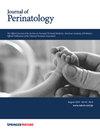Predictive model of ibuprofen treatment failure in very preterm infants with patent ductus arteriosus using machine learning techniques
IF 2.4
3区 医学
Q2 OBSTETRICS & GYNECOLOGY
引用次数: 0
Abstract
The approach to patent ductus arteriosus (PDA) remains controversial. We aim to develop an algorithm to predict ibuprofen treatment failure (TF) using machine learning (ML) techniques. Secondary analysis of a trial of very preterm infants receiving intravenous ibuprofen to treat PDA. A predictive model on TF was developed with ML. The impact of TF on outcomes was analyzed. One hundred forty-six infants were included. ML techniques showed that a logistic regression model predicted TF with an AUC 0.65. A multiple regression model found that bronchopulmonary dysplasia (BPD) was associated with TF, p = 0.03. Other neonatal outcomes did not differ between the study groups. It is feasible to build a predictive model of ibuprofen TF with ML that could assist clinicians during the PDA treatment decision-making process. The identification of responders prior to intervention would mitigate adverse effects in non-responders, providing them with an alternative approach.

利用机器学习技术预测动脉导管未闭早产儿布洛芬治疗失败的模型。
背景:动脉导管未闭(PDA)的入路仍有争议。我们的目标是开发一种算法来预测布洛芬治疗失败(TF)使用机器学习(ML)技术。方法:对一项极早产儿静脉注射布洛芬治疗PDA的试验进行二次分析。用ML建立了TF的预测模型,分析了TF对预后的影响。结果:纳入146例婴儿。ML技术表明,逻辑回归模型预测TF的AUC为0.65。多元回归模型发现支气管肺发育不良(BPD)与TF相关,p = 0.03。其他新生儿结局在研究组之间没有差异。结论:建立布洛芬TF与ML的预测模型是可行的,可以辅助临床医生进行PDA的治疗决策。在干预之前识别应答者将减轻对无应答者的不良影响,为他们提供另一种方法。
本文章由计算机程序翻译,如有差异,请以英文原文为准。
求助全文
约1分钟内获得全文
求助全文
来源期刊

Journal of Perinatology
医学-妇产科学
CiteScore
5.40
自引率
6.90%
发文量
284
审稿时长
3-8 weeks
期刊介绍:
The Journal of Perinatology provides members of the perinatal/neonatal healthcare team with original information pertinent to improving maternal/fetal and neonatal care. We publish peer-reviewed clinical research articles, state-of-the art reviews, comments, quality improvement reports, and letters to the editor. Articles published in the Journal of Perinatology embrace the full scope of the specialty, including clinical, professional, political, administrative and educational aspects. The Journal also explores legal and ethical issues, neonatal technology and product development.
The Journal’s audience includes all those that participate in perinatal/neonatal care, including, but not limited to neonatologists, perinatologists, perinatal epidemiologists, pediatricians and pediatric subspecialists, surgeons, neonatal and perinatal nurses, respiratory therapists, pharmacists, social workers, dieticians, speech and hearing experts, other allied health professionals, as well as subspecialists who participate in patient care including radiologists, laboratory medicine and pathologists.
 求助内容:
求助内容: 应助结果提醒方式:
应助结果提醒方式:


